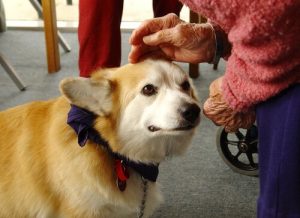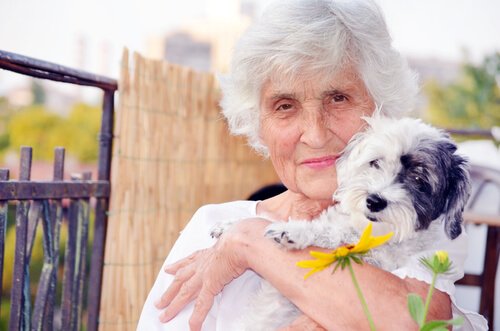Dogs That Heal: Canine Assisted Therapy

The use of animals in therapy has been gaining in popularity recently. Studies confirm how beneficial animals can be for the physical, mental and emotional health of humans. Perhaps because they’re “man’s best friend,” dogs are ideal. In this article, we’ll tell you about canine assisted therapy and why it’s so beneficial.
Dogs can heal us
Canine assisted therapy, or animal assisted therapy in general, aims to fill the physical, psychological, cognitive and social needs of patients. The dogs act like a bridge of communication between therapists and patients.

How is it done? Well, one thing you know is that dogs give unconditional, nonjudgmental, unbiased love — unlike many of our fellow humans. This is an essential point for people who feel vulnerable because of their physical, mental or emotional condition.
Dogs don’t notice the little things that may make humans feel uncomfortable or reject others. People feel safe with dogs. And that’s how dogs, with training and always under the supervision of a professional, aid in the recovery process.
What does canine assisted therapy involve?
Therapy can be carried out in different contexts: group or individual therapy. When a patient interacts with the dog, they temporarily forget their painful or difficult situation. It’s a positive break in their routine.
The benefits of this therapy have been demonstrated in situations as diverse as (for example):
- Alzheimer’s disease
- Autism
- Terminal illnesses
- Mental illness
- Heart disease
- Cerebral palsy
- Behavioral disorders
Also, while the positive effects may be more visible in children and the elderly, rape victims and convicts have also seen excellent results with therapy dogs. Social reintegration can be easier and more successful with canine assisted therapy.
Benefits of canine assisted therapy
Animal assisted therapy helps with:
- motor skills and balance
- verbal interaction between members of a group
- concentration and attention span
- self-esteem
- vocabulary
- anxiety and feelings of loneliness
- memory
Dogs and vulnerable teens
One great example is an unusual program involving teens and dogs in Spain. Adolescents who live in residences supervised by the government of Catalonia have seen positive results from canine assisted therapy.
“If something goes wrong, they make you forget,” says one teen about the dogs that participate in the program [translated]. The dogs help them deal with their fear, anxiety, and worries.
Members of the program share stories their stories. One lost his family during the voyage migrating from Africa to Europe. Another boy was left without legs after a terrible accident. Interaction with animals is a crucial part of undoing the pain that these young people have gone through.
Dogs help us; we should help them too

Ever since the fates of man and dogs crossed, dogs have always done us good. However, our attitude towards them has fallen short. We’ve often responded to their love with violence: abandonment, exploitation, physical abuse…
Even so, they are still loyal to us. We should learn from their example and let them make us better people.
The use of animals in therapy has been gaining in popularity recently. Studies confirm how beneficial animals can be for the physical, mental and emotional health of humans. Perhaps because they’re “man’s best friend,” dogs are ideal. In this article, we’ll tell you about canine assisted therapy and why it’s so beneficial.
Dogs can heal us
Canine assisted therapy, or animal assisted therapy in general, aims to fill the physical, psychological, cognitive and social needs of patients. The dogs act like a bridge of communication between therapists and patients.

How is it done? Well, one thing you know is that dogs give unconditional, nonjudgmental, unbiased love — unlike many of our fellow humans. This is an essential point for people who feel vulnerable because of their physical, mental or emotional condition.
Dogs don’t notice the little things that may make humans feel uncomfortable or reject others. People feel safe with dogs. And that’s how dogs, with training and always under the supervision of a professional, aid in the recovery process.
What does canine assisted therapy involve?
Therapy can be carried out in different contexts: group or individual therapy. When a patient interacts with the dog, they temporarily forget their painful or difficult situation. It’s a positive break in their routine.
The benefits of this therapy have been demonstrated in situations as diverse as (for example):
- Alzheimer’s disease
- Autism
- Terminal illnesses
- Mental illness
- Heart disease
- Cerebral palsy
- Behavioral disorders
Also, while the positive effects may be more visible in children and the elderly, rape victims and convicts have also seen excellent results with therapy dogs. Social reintegration can be easier and more successful with canine assisted therapy.
Benefits of canine assisted therapy
Animal assisted therapy helps with:
- motor skills and balance
- verbal interaction between members of a group
- concentration and attention span
- self-esteem
- vocabulary
- anxiety and feelings of loneliness
- memory
Dogs and vulnerable teens
One great example is an unusual program involving teens and dogs in Spain. Adolescents who live in residences supervised by the government of Catalonia have seen positive results from canine assisted therapy.
“If something goes wrong, they make you forget,” says one teen about the dogs that participate in the program [translated]. The dogs help them deal with their fear, anxiety, and worries.
Members of the program share stories their stories. One lost his family during the voyage migrating from Africa to Europe. Another boy was left without legs after a terrible accident. Interaction with animals is a crucial part of undoing the pain that these young people have gone through.
Dogs help us; we should help them too

Ever since the fates of man and dogs crossed, dogs have always done us good. However, our attitude towards them has fallen short. We’ve often responded to their love with violence: abandonment, exploitation, physical abuse…
Even so, they are still loyal to us. We should learn from their example and let them make us better people.
This text is provided for informational purposes only and does not replace consultation with a professional. If in doubt, consult your specialist.








